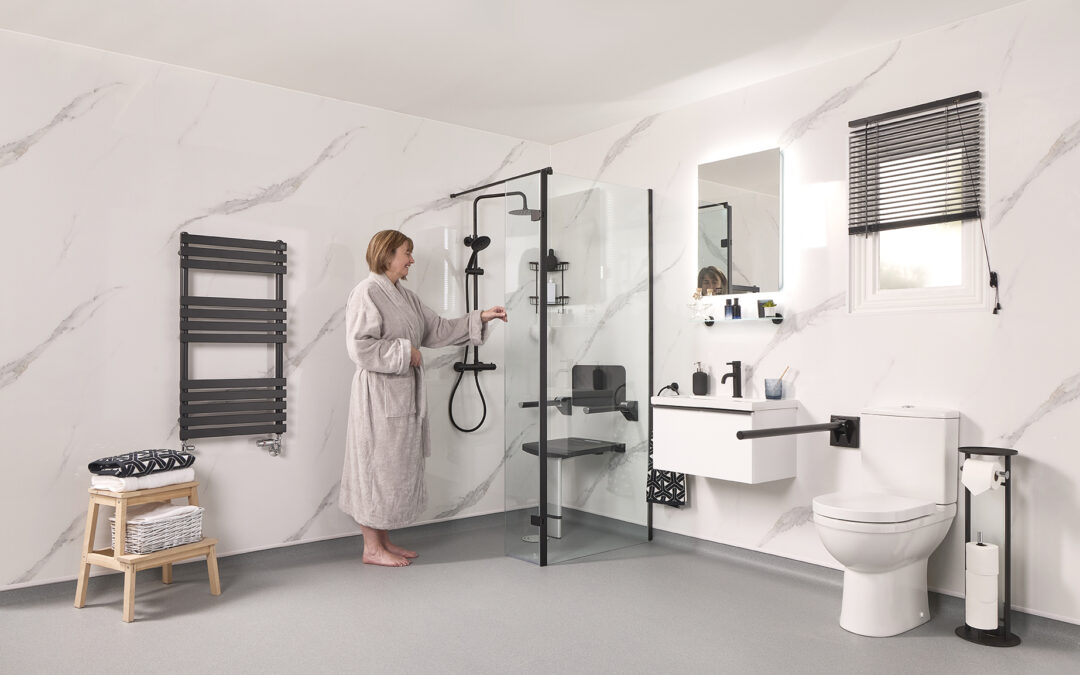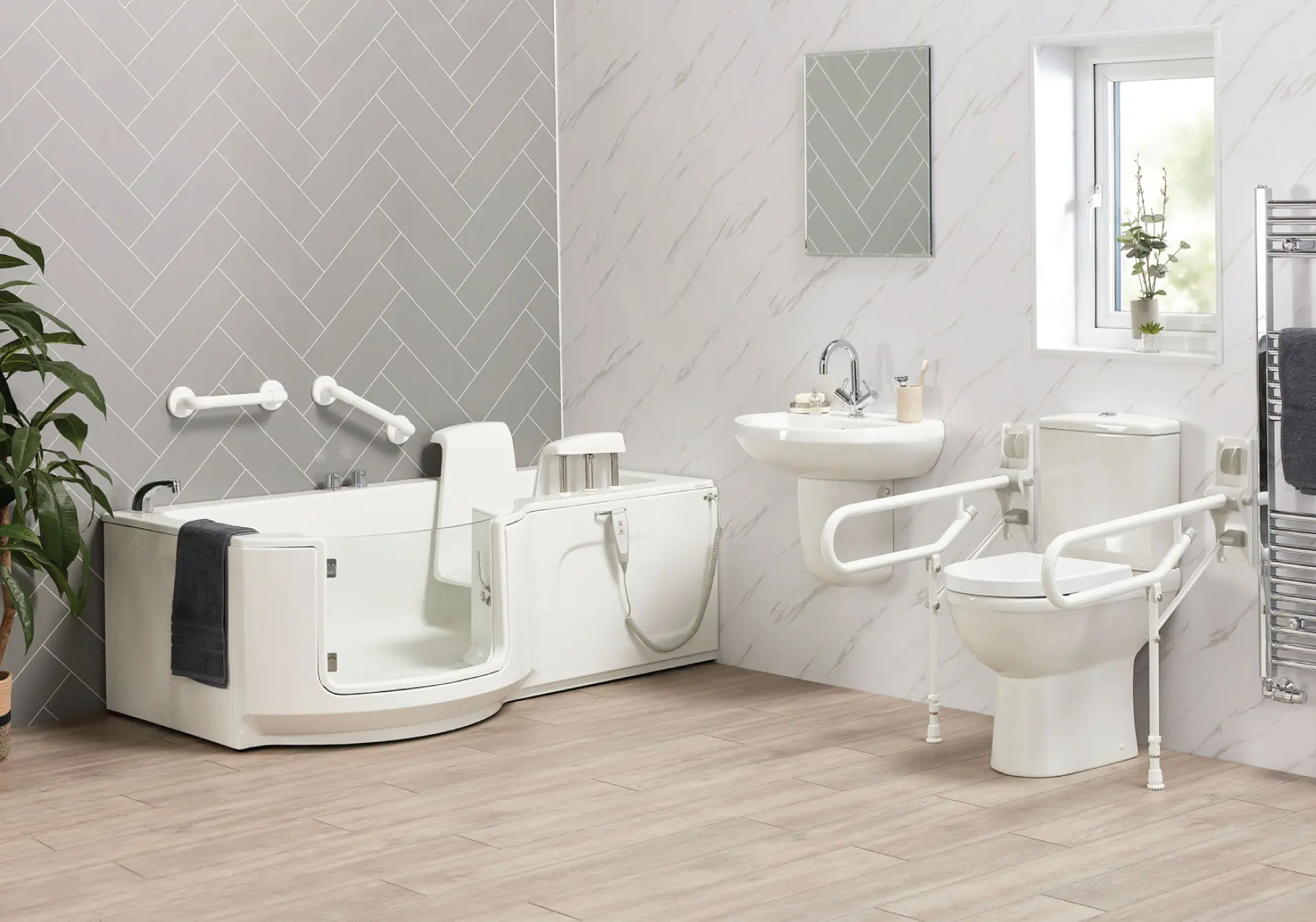Table of Contents
In UK bathrooms, the main fall drivers are slippery floors, poor lighting, hard-to-reach fixtures, mobility decline, and medical factors (vision, dizziness, meds). The biggest wins: wet-rated anti-slip surfaces (PTV ≥36), bright, even lighting (with night-lights), grab rails + seated showering, level access, and routine home checks. Falls affect ~1 in 3 aged 65+ and ~1 in 2 aged 80+ each year—so the bathroom deserves priority.
1) Slippery floors
Why it happens: Water + smooth enamel/tiles/soap films cut friction.
What to do (now):
-
Fit wet-rated anti-slip flooring or a textured tray; aim for PTV ≥36 in wet areas.
-
Add a return/deflector panel and point the shower head inward to reduce overspray.
-
Keep a squeegee handy and clean residue regularly (grip drops when surfaces are greasy/soapy).
2) Poor lighting
Why it happens: Shadows, glare, or no night lighting hide edges and water.
What to do (now):
-
Use bright, even lighting and add night-lights for evening visits.
-
Choose higher-contrast finishes so edges, rails and the seat are easy to see.
-
Make switching easy: big rockers, pull cords, or motion/low-level guidance lights.
3) Hard-to-reach fixtures
Why it happens: Controls positioned beyond safe reach; storage too low/high.
What to do (now):
-
Put shower controls near the entry and reachable while seated.
-
Swap to lever-style mixers; add a hand-held shower on a sliding rail.
-
Move everyday items to shoulder–hip height; add an in-shower niche within seated reach.
4) Mobility decline
Why it matters: Transfers in/out of the shower or bath are energy-intensive; balance and strength drop with age or illness.
What to do (now):
-
Install grab rails at the entry, beside the seat, and exit (fixed into structure).
-
Add a fold-down shower seat; consider a bath board/transfer bench if using a tub.
-
If step-over is the issue, switch to level access.
5) Medical conditions & meds
Why it matters: Dizziness, low vision, neuropathy, and certain medicines increase fall risk.
What to do (now):
-
Book medication and vision checks (free NHS eye tests 60+).
-
Address hearing/balance concerns; consider strength and balance exercises recommended by NHS services.
6) Prevention strategies that work (UK evidence & context)
-
Scope the bathroom first: RoSPA highlights the bathroom as a high-risk room, with tens of thousands of A&E attendances and dozens of deaths from bathroom falls annually—design out hazards early.
-
Target the big wins: anti-slip (PTV ≥36), good lighting, grab rails + seat, and level access—paired with regular home safety checks promoted by NHS services.
-
Remember the scale: NICE reports ~1/3 of 65+ and ~1/2 of 80+ fall yearly—home adaptations matter.
-
National picture of harm: RoSPA’s recent analysis across UK nations shows falls are the leading cause of accidental death and hospital admissions from accidents—underlining why bathroom prevention is vital.
Cause → Prevention (at-a-glance)
| Cause | Why it leads to falls | What to do (prevention) |
|---|---|---|
| Slippery floors | Low friction from water/soap on smooth surfaces | Wet-rated anti-slip (target PTV ≥36); squeegee and clean; add return/deflector panel; orient shower head inward. |
| Poor lighting | Can’t see hazards, water, or edges | Bright, even lighting; night-lights; reduce glare; use high-contrast finishes for rails/seat/edges. |
| Hard-to-reach fixtures | Overstretching and twisting | Controls at entry and seated reach; lever mixers; hand-held shower; storage at shoulder–hip height. |
| Mobility decline | Transfers are tiring/unstable | Grab rails (entry/seat/exit) fixed into structure; fold-down seat; bath board/transfer bench; move to level access if step-over is unsafe. |
| Medical factors | Dizziness, vision loss, neuropathy, meds | NHS medication/vision reviews; balance/strength exercises; simplify layouts; add seating. |
Bathroom fall-prevention checklist (copy-paste/print)
- Wet-rated anti-slip (target PTV ≥36) and regular cleaning
- Bright, even lighting + night-light route to bathroom
- Grab rails at entry, beside seat and at exit (fixed into structure)
- Fold-down shower seat or bath board/transfer bench
- Controls reachable from entry and while seated; lever mixers
- Hand-held shower on sliding rail; head aimed inward
- Level access (no step) or lowest possible threshold
- Storage at shoulder–hip height; in-shower niche within reach
- Routine home safety checks (declutter, dry floors, remove loose mats)
- Medication & vision reviews; strength/balance exercises if advised
FAQs
How common are falls among older adults in the UK?
NICE reports around a third of people aged 65+ and around half of those aged 80+ fall at least once a year.
Are bathrooms really that risky?
Yes. RoSPA highlights bathrooms as a high-risk room, with >54,000 A&E attendances and 80+ deaths annually from bathroom falls (England & Wales estimates). Designing out hazards (anti-slip, rails, lighting) is strongly recommended.
What’s the fastest improvement I can make?
Upgrade to a wet-rated anti-slip surface (PTV ≥36) and add grab rails at entry/seat/exit. Pair with bright, even lighting and a night-light path.
Who can help me decide between modifications and a bigger refit?
Request a home assessment via NHS/local services, or book a specialist adaptations visit to scope level access, seating, rails and anti-slip options.












